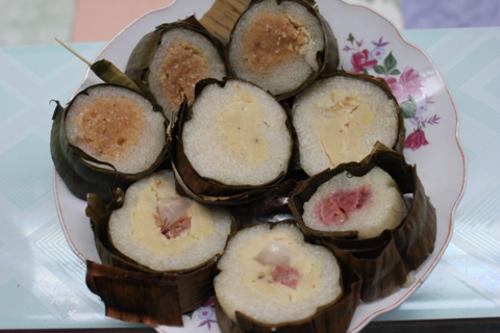In recent few days, my heart has been waving up when my friends in Vietnam from Saigon, Hanoi, Da Nang…. to other regions began preparing for Tet holiday. Perhaps because this is my first Tet holiday away from home in the bitter cold with snow white falling down outside. But it is completely a new experience.
I remember the bustling atmosphere in the days to reach New Year. Starting from December 20 lunar calendars, house to house, people prepare for New Year shopping. Almost every year, normally on 28th December (lunar month), my grandfather prepares for wrapping Tet Cake or Sticky Rice Cake.
There is a difference between Sticky Rice Cake in the North and the South of Vietnam. When Chung cake is popular in the North (See How to make Square glutinous rice cake), Tet Cake is an important food on the altar in the South. Tet Cake is a Vietnamese savory but sometimes sweetened made primarily from glutinous rice, which is rolled in a banana leaf into a thick, log-like cylindrical shape, with a meat or vegetarian filling (such as green beans), then boiled in 8 to 12 hours. After cooking, the banana leaf is removed and the cake is sliced into wheel-shaped servings.
I usually help grandfather with wiping the leaves of Su banana and he teaches me the traditional way to make a Tet Cake. The ingredients required includes glutinous rice, green bean, fatty pork and black pepper, salt, sometimes green onion for spices. In the wrapping stage, one needs banana leaves. Banana leaves have to be washed carefully in order to preserve the taste of the cake and may be steamed so that they can become flexible and soft enough for wrapping. People often choose high quality rice and bean for making Tet Cake; green bean is soaked in water for 2 hours and 12 to 14 hours for glutinous rice. The fat and lean pork is preferred for Tet Cake because its fatty flavor well associates with the glutinous rice and green bean. After being sliced in big parts, pork is mixed with pepper, onion and salt.
After adding all the ingredients, cakes must be wrapped in the leaves of Su banana. These leaves are what give the cake its color, which can be kept for between 15 and 30 days. Even tying the cake takes skill. It must not be too loose or too tight. Difficulty in making Tet cake is that we have to pack tightly but the banana leaves are not torn and the cake is slime and beautiful when cooked.
In the afternoon, after the packaging is completed, grandfather took three bricks to make a place for cooking. My grandfather often spends a sleepless night to look after the cake cooker which will not be done until the next morning.
It can be said for Vietnamese living oversea, though it does not truly fully complete, but a Tet cake from Asian markets in Tokyo moves up as well as our warmth with a little taste of home. This year, some students at Osaka also came to our province in order to prepare for college entrance examination and group of Vietnamese students from many universities came and we sat side by side in a small room with stories of students away from home in Eve moment.
I remember the moments of suspense waiting for the moment Eve fireworks with sound and a special performance on the Han River in Da Nang city and then waiting for the morning to go to the temple for praying luck in New Year. We are excited to wait for the first meal when my mother cuts Tet cakes for us. The cake is eaten during the Vietnamese Lunar New Year holiday, dipped in fish sauce with or without chilly, and can be eaten together with pickled scallions. The cake can also be fried.
Almost every day on Tet Holiday, I eat delicious food that I just can eat once in the whole year. That beam pork sauce, thinly sliced, rolls with vegetables and eat by dipping in fish sauce. Kitchen and interior space seems full with Tet cake, baking cake, spring rolls and all kinds of sausage and dried beef. That’s the flavor of the dish on New Year but until now I still remember in the months away from home.
Learn how to make Tet cake of people in the West of Vietnam.
Source: Cocdoc.fpt.edu.vn


